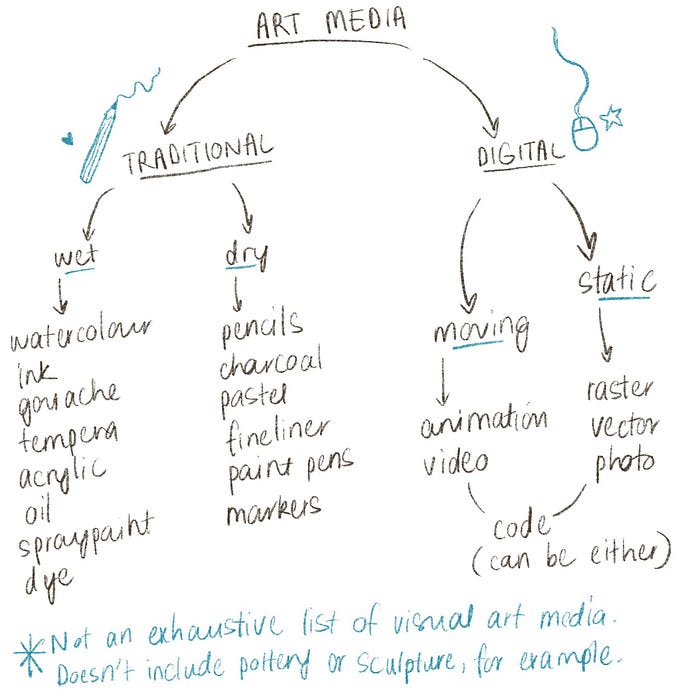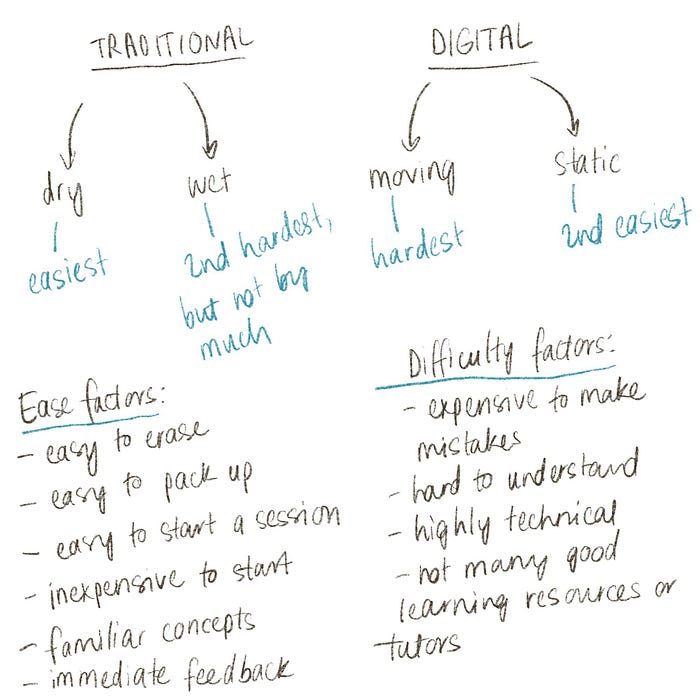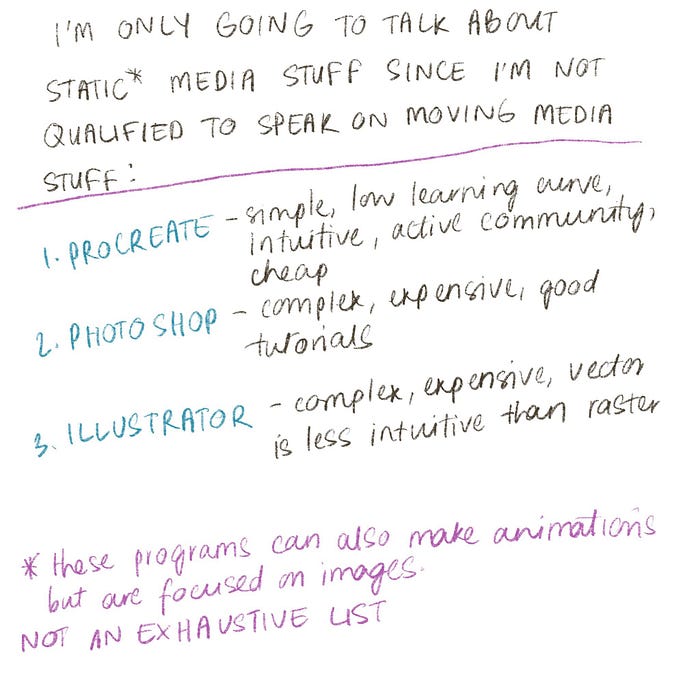Hello! This is for anyone who wants to learn visual art but doesn’t know where to start. Learning art is a very multifaceted thing (which media do you start with? How do you learn creativity? What about the physical side of drawing?), so I’ve broken down the different aspects of learning art into a few different maps (for simplicity’s sake, I’ve narrowed my focus to 2D visual art, and so have left out things like fabric art, sculpture, pottery etc).
First, we can split our learning journey into two main parts: mechanical skills and media knowledge. “Mechanical skills” refers to what our bodies can do (weird as that sounds) while “media knowledge” is more about what the materials can do. Some examples of mech. skills would be hand-eye coordination, line control, drawing shapes, colour blending, etc. Examples of media knowledge are knowing the difference between a raster and vector image, the difference between watercolour and gouache, how to layer acrylics and gouache, etc. Mechanical skills can be applied no matter which medium you’re using, while media knowledge is more niche and specific (but will usually help with learning other forms of media). Some things will require both knowledge domains (for example, blending colours requires knowledge of how the medium works, blending methods and the ability to critique your work until you’ve achieved the texture and gradient you want in your blend).

Let’s focus on the media knowledge part of our map first. There are broad categories we can split media into:

Here’s what I think the difficulty levels of each media type are:


If we focus on the traditional branch first, this can be split up into “wet” and “dry” media (generally, wet media requires liquid and brushes, while dry media doesn’t). Since pencils are a tool we’re already used to, dry media is the easiest for most people to learn. Using a tool we’re already familiar with reduces the overall “burdens” of learning (instead of having to learn how to manipulate the tool and how to draw, we only have to think about the drawing part). Here’s my difficulty map for dry media:

Here’s my difficulty map for wet media:

If you’d like to be a digital artist, I do think it’s still helpful to learn pencil drawing first, since as previously mentioned pencils are a thing we already know how to use. Drawing on paper is a good way to practice mechanical skills like lines and shapes without having to focus on how to use software. Here’s my difficulty map for the different types of software you could use:

So to sum up, here are the different maps for each media goal you might have:


Note: Only follow these pathways if you want to explore and learn multiple things. You don’t NEED to know acrylic to learn oil painting, or to know Procreate to learn Photoshop. It would help for sure, but it’s really not worth learning an entire medium or software if you’re only learning it to learn something else. If you are laser-focused on one medium, go for that one — just be aware of its difficulty level, and perhaps dabble in the preceding levels of difficulty before it (rather than going full-ball on absolutely everything). The only medium I recommend learning no matter what your focus is is graphite pencil.
Mechanical Skills
Here’s my map of mechanical skills:

Even though I’ve drawn these in a progressive line, it isn’t a good idea to try and master one completely before moving onto the next. These skills are all very interconnected, meaning that knowledge in one will boost your skills in others. For example: the better you are at linework, the better you’ll be with shapes and texture. The better you are at shapes, the easier learning perspective will be and learning about colour will help you with light and shade.
It’s a better idea to work on one (or two skills at most) for a determined period of time, then to swap. An example would be to work on shape and line exercises for two weeks, then focus on using those skills to practise basic shading skills for three weeks. The order that I’ve written them down in is the general order I recommend moving through them in, but since everyone is different, it’s best to have an experienced artist or tutor look over your work every now and then to suggest nudges or edits to your skill pathway.
Combining Skills and Knowledge
So now you have an outline for your media pathway and your skills pathway, but how do you put them together?
Choose a medium and work your way through the skills pathway until you’re fairly comfortable with the medium. When you feel like you’re ready, move onto the next medium and test yourself with the skills pathway again.
If you aren’t sure how to judge when you might be ready to move onto another skill or medium, this is a simplified version of the rubric I use with my students:
- Can you do the set task?
- Can you do it well?
- Can you do it well without external help or input?
- Can you reliably do the previous step (in other words, you know that you can Do The Thing on demand and it wasn’t just a lucky fluke that happened that one time)?
To be honest, I don’t think that a good test of creative competence is whether you can fulfill certain technical requirements — it’s whether you can think of an idea and make it happen the way you wanted or imagined it. This is an important thing to remember when you’re learning since art is so subjective — if you’re making things that make you happy, then you’re doing well. This perspective might seem to be the opposite of the steps I outlined above, but they actually help to explain it. When you’re deciding a set task, it’s something you get to choose. You set the boundaries of what “doing it well” means, and only you know if a piece of art comes out the way you intended. It definitely helps to have an outside voice point out things you might have missed, but even then it’s you who decides whether that feedback is useful to your workflow and results or not*.
*This means that self-awareness and honesty is very important. You don’t want to brutalise your ego and self-esteem by giving yourself emotionally devastating feedback, but you also don’t want to give yourself so many concessions that you never actually learn anything. For a while at the start, you’ll be adjusting your imagination to the boundaries of your current skills, but as you go along you’ll be able to more deliberately build your skillset to match your imagination.
Notes
- No matter which media you choose to try first, start out using black and white only. Using fun colours can distract you from properly critiquing your work when you’re at the beginning of your journey.
- You’ll have a period where you start hating absolutely everything you draw. This is okay (good, actually) and totally normal. Novice artists tend to develop their personal tastes and critiquing skills before they develop their mechanical skills (meaning they can identify what they don’t like about their drawings before they have the ability to fix it. So if you find yourself at this stage, it means you’re growing and shouldn’t give up!)
- It helps to find a community or another learner to be around so you can give feedback to each other. This will help your critiquing skills develop a lot!
- Developing a solid set of self-critiquing skills is really important. Self critique is the ability to look at your drawings and pick out what you’d adjust if you were to perfect it.
- The best way to learn something is to teach someone else. Explain your process to yourself if not to someone else, and try to write down things you learn in a way that a total beginner would be able to understand.
- Developing your own art style takes a lot of time and it helps to learn how to draw figuratively (realistically) before trying to develop it. This is because knowing how to draw realistic figures gives you an established framework to critique from (“that’s not what a rectangle/eye looks like”, “legs can’t really bend like that”) which is easier for beginners to do. When we know how to draw realistically enough and we’re good at self-critiquing, we tend to have a fairly developed sense for designing unrealistic figures that still look good.
That’s It!
Good luck with your drawing adventures! I’ll be making a few other art-related guides in a series (watercolour, digital art, shading techniques, etc) so leave a comment if there’s a particular art thing you’d like me to write about :)
